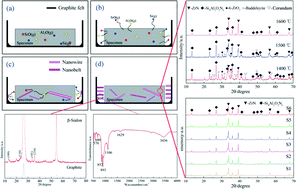Growth mechanism and PL properties of β-sialon nanobelts/nanowires synthesized by a process of aluminothermic reduction nitridation of zircon
Abstract
Large scale β-sialon nanobelts/nanowires and ZrN–sialon composite powders were prepared via aluminothermic reduction nitridation under different conditions with flowing N2. The phase composition, morphology, and microstructure of the as-prepared products were characterized by X-ray diffraction (XRD), field emission scanning electron microscopy (FESEM), transmission electron microscopy (TEM/HRTEM), Fourier-transform infrared spectroscopy (FT-IR) and energy dispersive X-ray spectroscopy (EDS). The experiment results show that the phase compositions and the ratio of nanostructures to powder can be tailored by the experimental conditions. The formation of β-sialon nanostructures was dominated by a vapor–solid (VS) mechanism. The photoluminescence spectrum of the β-sialon nanostructures exhibits a special emission peak located in the violet–blue spectral range, making possible potential applications in blue-light emitting diodes and display devices. This process also provided a feasible way to prepare reinforcing β-sialon nanostructures in situ within the ZrN–sialon composite powders.


 Please wait while we load your content...
Please wait while we load your content...